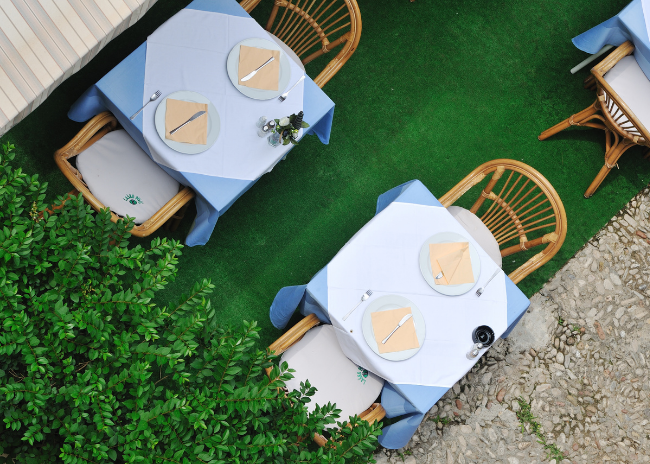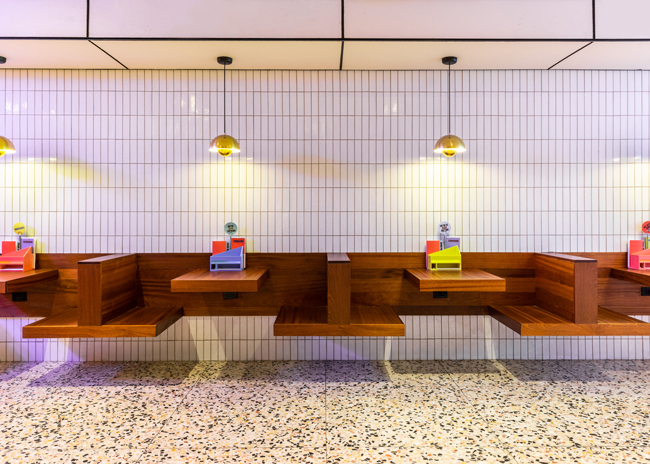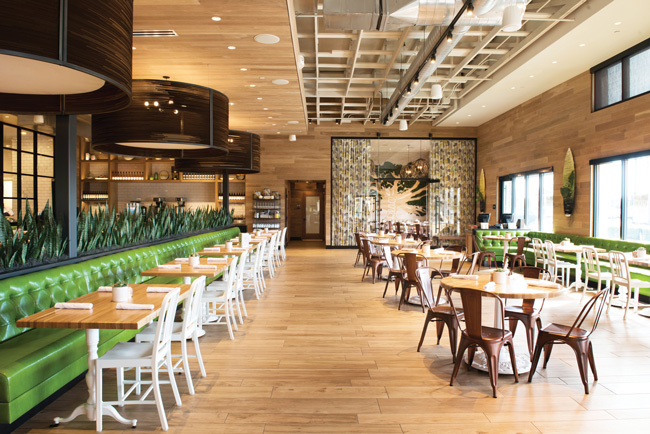Outdoor dining dominated in 2020 in the wake of the COVID-19 pandemic, and many operators believe it will continue to do so in 2021, according to a December survey of rd+d subscribers. More than a third, 34.02%, felt outdoor dining’s popularity would continue into 2021 and beyond. Outdoor dining was also named the area where rd+d readers saw the most investment in 2020, with 40.85% of surveyed readers saying they saw increased investment in that area. Some readers even added comments noting that they would double down on their successes in 2020 and continue to invest in outdoor dining including expanding outdoor dining spaces, adding outdoor amenities, and work to make outdoor areas more functional overall, particularly with an eye to make dining al fresco a year-round option.
Even with the assumption that life will largely return to normal some time in 2021, outdoor dining has become a lifeline for many restaurants in the wake of mandated dining room closures and a signal of safety to nervous diners. Going forward, it’s safe to assume rooftops and patios for all types of foodservice facilities will offer expanded opportunities for revenue via additional seating.
Despite drive-thrus ascending popularity, a flurry of new chain prototypes across all segments that debuted over the winter prominently feature outdoor dining wherever space allows. From Fogo de Chão to Pokéworks, everyone understands the curb appeal of outdoor dining.
For these restaurants, outdoor furniture is an essential element. Tables and chairs are distinguished from those used indoors by finishes that are specifically designed to withstand the elements. UV rays, extreme temperatures and moisture are examples of what chairs, tables and umbrellas are subjected to, and all can be very destructive over time. Location also makes a difference. For example, the impact of furniture exposed to salty ocean air is often overlooked, but it can cause corrosion and rust on raw steel or cast-iron surfaces.
Along with upholstery and foam made for outdoor use, tables need to be attractive and durable as these are a touch point for diners. Umbrellas that provide necessary shade can be cantilevered or surface mounted, depending on the space. As for calculating the number of seats, as with indoor spaces, it depends on the volume capabilities of the kitchen.
Durable Material Selection
Similar to indoor furniture, when specifying outdoor furniture, the focus should be on durability. Outdoor furnishings are typically lighter in weight in order to be easily relocated, weather resistant to keep up appearance over time, and made with materials that resist mold and mildew. Some furniture can be utilized both inside and outside, depending on the type and style.
The most widely used materials for use on patios and decks are powder-coated steel or aluminum. Because powder coating protects metal against the elements, it is suitable for any season. However, it’s important to note that hand-painted metals do not typically hold up to outdoor elements for an extended period of time.
Although not as widely used due to more extensive maintenance requirements, some wood types including redwoods and Indonesian hardwoods like teak do not radiate or retain heat like metal or copper. They are suitable for outdoor furniture due to their weather resistant properties. Plywood, walnut and most other woods are not a good choice for outdoor spaces, as they are not weather resistant. Depending on the type, wood finishes can also fade in the sunlight. To combat this, periodic sealing and treatment with oil can help maintain the wood’s appearance and integrity. There is also the option of eco-friendly recycled wood furniture that is treated to better withstand sun, rain and humidity.
Operators can incorporate outdoor furniture made of plastic that is UV protected and provides a longer service life. Of course, concrete, cast iron, fabricated steel and polymer also make solid, sturdy choices, though some are much heavier than others. Consider the type of application and the need for mobility when specifying these materials.
Newer material types rated for outdoor use are growing in number. For example, one manufacturer incorporates recycled plastic lumber in its design resulting in a material that is low maintenance and incorporates UV inhibitors to prevent premature fading.
Fabrics must be exterior grade to withstand solar exposure. Polypropylene is the most common, as it is UV resistant and does not retain moisture. Other common outdoor seating materials are PVC mesh, olefin, wicker, rope, polyester and marine vinyl.
Design Trends to Consider
With outdoor dining rising in popularity, there has been an increased need for furniture that offers maximum flexibility but also transforms and expands outdoor spaces to include outdoor bars and lounges and waiting areas. This has led designers and operators to work in a variety of seating options, with lounge pieces mixed in with tables and high-tops in order to accommodate patrons. These pieces may also be changed in and out, depending on the day part. For example, a bar area open in the evening may require more high-tops or lounge seating that is not necessary for breakfast or lunch hours.
Coverings and components that help establish a level of privacy in outdoor dining spaces also have become more common. This may include planters with high plants or trees, for example.
When it comes to ambience, casual restaurants are more apt to have a rustic feel with picnic-style tables or wood furniture with a DIY vibe. But custom pieces and industrial aesthetics have become more common, especially at trendier restaurants.
There’s been increasing use of recycled plastic incorporated into furniture design as it is extremely durable and requires little maintenance.
Creating outdoor spaces that mimic indoor spaces is on trend, as well, for continuity and branding purposes. These designs typically focus on comfort and warmth, with a casual appearance and feel. Of course, post-pandemic, the biophilia trend — making the indoors feel more like the natural world — is likely to trend as nervous diners are lured back inside.
Purchasing Considerations
Standard outdoor furniture varies, depending on the operation. While a rooftop bar may require lounge seating, including sofas, side tables, high-top tables and bar stools, outdoor eating areas in any eatery can be a mix of chairs, benches, upholstered lounge seating and picnic tables. Depending on the setting and type of operation, umbrellas, heaters and waste receptacles may be part of the package.
When determining the number of seats, the same spacing calculations should be used outdoors as with indoor space. An operator also needs to follow ADA requirements on patios and rooftops.
Material preference is a key factor when choosing tables and chairs. All furniture should be rated for commercial and outdoor use, which ensures longevity. Operators need to consider their specific location when specifying fabrics and their UV ratings and mold and mildew resistance to make sure it doesn’t prematurely fade or deteriorate. The same is true for wood on tables, chairs and other aspects of the space like umbrellas and planters. With powder coated metals, the tubing should be inspected to make sure the finish covers enough of the inside to prevent rusting from the inside out.
Weight is another consideration, as outdoor furniture tends to be moved around more often than pieces used indoors. It should be heavy enough to withstand strong winds, yet light enough to be easily relocated for storing.
While upholstery on chairs and furniture used indoors is often permanently installed, outdoor cushions are more likely to be removable, and may have covers that can be machine washed. Darker colors or busy patterns will hide dirt and imperfections better than light colored fabrics.
Aesthetics and design are top considerations for outdoor spaces, as these often are a customer’s first impression of a restaurant. The more comfortable the seating is, the longer customers will stay.
Size, flexibility and ease of configuration should be considered when specifying. The ability to break up tables or put them together for different size parties enhances the versatility of the space. Operators also should take into account the allocated space for furniture storage if the outdoor space is only used seasonally. The ability to stack chairs if storage space is at a premium should also be considered. Furniture and accessory heights should be oriented to hide or take advantage of the location’s surroundings and views.
When looking for outdoor seating, it’s especially important that table bases and chair legs are easy to stabilize on uneven surfaces, such as wood decks or paver patios. A good table base that can be easily adjusted will save a lot of headaches.
The most common mistake made in outdoor furniture specification and purchasing is solely focusing on price. Instead, look at long-term warranties and the availability of replacement parts. Other common mistakes include trading value for durability. Cost-benefit analysis is important with all furniture, but outdoor elements can quickly and easily destroy inferior products. Operators should ensure materials are designed to withstand harsh environments over time. The logistics of storing or securing outdoor furniture when it’s not in use should not be overlooked. Having the space for storage during off hours or cold weather is a must. Also, depending on the location, a large security cage or chains with a lock may be needed to prevent theft.
Cleaning & Maintenance
Reviewing the care and maintenance instructions and the warranty information for outdoor furniture provides insight into keeping it looking like new as well as functional. These products should not only be rated for commercial use and outdoor spaces, but they should also be easy to maintain.
Outdoor furniture will need continual cleaning and some maintenance. Depending on the type, most outdoor tables, chairs and umbrellas can be hosed off or wiped down with soap and water. The regimen is the same for chair and sofa cushions and upholstery. Some seat coverings may be removable for laundering.
Some materials are easier to clean and stay clean better than others. The simpler and smoother the lines and design, the easier thorough cleaning will be. Those with open web and filigree types are more difficult to maintain since there are nooks and crannies that hold debris and dust.
Chairs should have replaceable glides on the legs to not only provide easy moving in and out from the table, but also to protect the outdoor floor surface from damage.
Outdoor dining — even year-round — is here to stay. Specifying and purchasing this type of furniture and furnishings should consider the segment type, the use, durability, cleanability, storage and maintenance. Careful consideration and planning will result in happier guests and a better bottom line.




